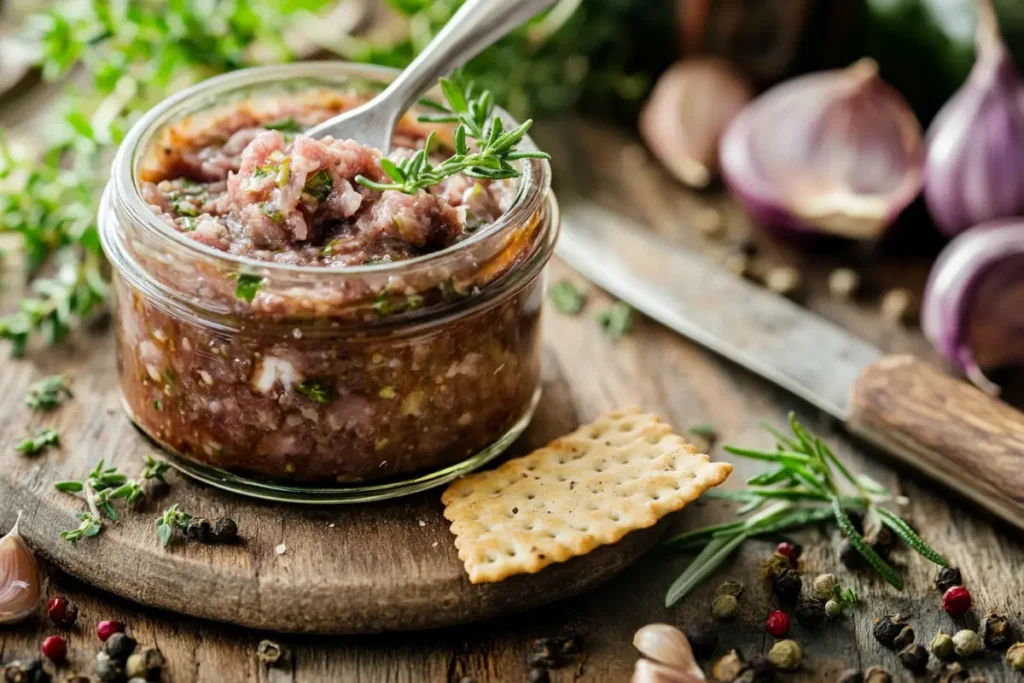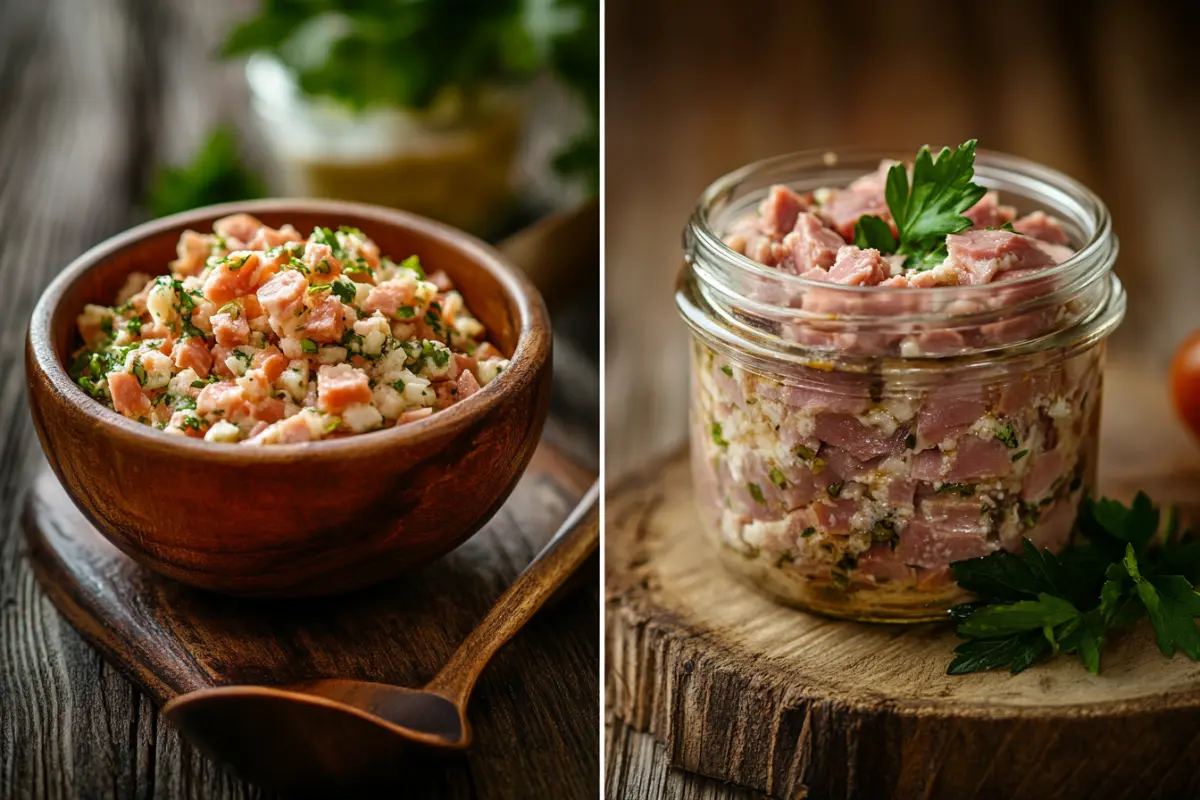Is Bologna Salad the Same as Potted Meat? This question has puzzled food lovers and culinary enthusiasts for years. While both are processed meat-based dishes and share some similarities, they are distinct in ingredients, preparation, and usage. In this article, we’ll uncover the unique qualities of these classic foods by exploring their origins, nutritional profiles, and cultural significance.
Introduction to Bologna Salad and Potted Meat
What Are Bologna Salad and Potted Meat?
At first glance, bologna salad and potted meat might seem similar since both fall under the umbrella of processed meat dishes. But here’s the thing: they each have their own unique story.
Cooks typically prepare bologna salad as a creamy spread using finely ground bologna, mayonnaise, and seasonings.. On the other hand, potted meat is a softer, preserved product, created by cooking and blending meat with fat, salt, and sometimes spices.
Why Are These Foods Confused?
The question “Is Bologna Salad the Same as Potted Meat?” often arises because of their similar textures and shared versatility. Both are commonly used as spreads or sandwich fillers, making them popular staples in budget-friendly meal planning. However, their ingredients and preparation methods differ significantly, resulting in distinct flavors, nutritional profiles, and culinary applications.
Purpose of Exploring These Foods
This article dives into the question, “Is Bologna Salad the Same as Potted Meat?” by exploring their history, recipes, and key differences. By the end, you’ll not only understand their unique characteristics but also appreciate their cultural significance. After all, food is more than nourishment—it tells a story
Understanding Bologna Salad

Definition and Ingredients
Bologna salad is a creamy, savory spread made primarily from ground bologna, blended with mayonnaise, pickles, and seasonings. It’s a versatile dish often enjoyed as a sandwich filling, cracker topping, or even a party dip. The star of the recipe—bologna—provides a rich, meaty flavor, while the mayonnaise adds a smooth, velvety texture. Pickles and seasonings, such as mustard or onion powder, give it a tangy kick that complements the other ingredients perfectly.
To learn more about bologna’s origins, nutritional content, and other recipes, check out our in-depth guide on Bologna Meat: History, Nutrition, and Recipes
This dish often caters to personal taste, allowing for substitutions and additions. For example, diced celery or hard-boiled eggs can be included for added crunch and flavor.
Preparation Methods
Making bologna salad is as straightforward as it is satisfying. Begin by finely grinding or chopping bologna—using a food processor ensures the ideal texture. Then, mix it with mayonnaise until you achieve a creamy consistency. Add finely diced pickles or relish for that tangy punch, and season to taste.
Serving suggestions vary widely. Spread it between two slices of bread for a classic sandwich, or serve it as a dip alongside crackers and fresh veggies. Some people even enjoy it as a side dish at picnics or family gatherings.
Variations Across Regions
Regional differences give bologna salad its charm. In some areas, it’s affectionately called “Monkey Meat.” Don’t let the name fool you—this quirky nickname has no connection to its actual ingredients. Recipes may also vary significantly by region. In the Midwest, you might find it made with sweet pickle relish, while Southern recipes often incorporate hot sauce or a dash of vinegar for extra zest.
These variations reflect local flavors and traditions, showing how a simple dish can adapt to suit a wide range of palates. People have embraced this humble dish, whether they call it bologna salad, monkey meat, or bologna spread, earning it a beloved spot in many homes.
While it’s easy to confuse bologna salad with potted meat due to their shared creamy texture, the ingredients and preparation clearly set them apart. And as you’ll see in the next section, potted meat takes a completely different approach to processed meat preservation.
Exploring Potted Meat

Definition and Ingredients
Manufacturers create potted meat as a finely textured, highly processed food product by blending cooked meat, fat, salt, and preservatives. Unlike bologna salad, which uses fresh ingredients mixed with mayonnaise, producers preserve potted meat for extended shelf life. The primary meats used include beef, pork, or chicken, though the exact contents can vary by brand.
The ingredients are emulsified into a smooth, spreadable consistency, with preservatives like sodium nitrite added to maintain freshness. Spices and flavorings—such as garlic powder or onion extract—are often included to enhance the taste, making it savory and mildly salty.
Historical Context
Potted meat has a rich history dating back centuries, originating as a preservation method in times before refrigeration. By cooking meat and sealing it with a layer of fat, it could be stored for weeks or even months without spoiling. This practice was particularly valuable during long journeys or for those living in rural areas with limited access to fresh food.
During the Industrial Revolution, potted meat became a commercial product, appealing to working-class families for its affordability and convenience. Over time, it evolved into the canned versions we see today, which are still a popular choice for budget-conscious consumers and those seeking quick, protein-rich meals.
Commercially Available Varieties
Today, many brands offer potted meat products, each with its own unique spin. Companies like Armour Star and Libby’s produce widely recognized versions that are affordable and shelf-stable. Some brands use higher-quality cuts of meat, while others focus on affordability, offering products with a mix of meat trimmings and fillers.
Varieties of potted meat differ not just in ingredients but also in flavor profiles. Some include added spices, such as paprika or cayenne, to cater to regional tastes. Others come pre-seasoned to suit specific recipes or preferences, making them a versatile option in the kitchen.
Though potted meat might not boast the fresh appeal of bologna salad, its origins as a practical preservation method and its adaptability to modern needs have cemented its place as a pantry staple in many households. Up next, we’ll dive into how these two foods compare directly in their ingredients, uses, and flavors.
Comparing Bologna Salad and Potted Meat
Ingredients and Preparation
Is Bologna Salad the Same as Potted Meat? At their core, both bologna salad and potted meat rely on processed meat as a base, but their similarities largely end there. Bologna salad is crafted with fresh ingredients like ground bologna, mayonnaise, and pickles, mixed into a creamy, tangy spread that requires no preservation. This makes it a fresher, homemade option often enjoyed immediately.
Potted meat, on the other hand, is a commercially processed product made by blending cooked meats, fat, salt, and preservatives. Its preparation involves emulsifying the ingredients into a smooth paste, designed for long shelf life thanks to added preservatives. Unlike bologna salad, potted meat is created with longevity and convenience in mind, rather than immediate freshness..
Texture and Flavor Profiles
Is Bologna Salad the Same as Potted Meat? One major difference lies in their textures and flavors. Bologna salad is chunky and creamy, combining smooth mayonnaise with crisp bits of pickles or celery. Its rich yet tangy flavor delivers a fresh, homemade taste that many enjoy in sandwiches or as a dip.
In contrast, potted meat features a smoother, mousse-like consistency. Manufacturers heavily season it with salt and spices, giving it a more savory and concentrated flavor. These distinctions in texture and flavor help clarify the question, “Is Bologna Salad the Same as Potted Meat?” and highlight how each product suits different culinary uses
Usage in Dishes
Bologna salad shines as a spread for sandwiches or crackers and can be served as a party dip. Its versatility makes it popular in picnic lunches and family gatherings.
Potted meat, being a softer and more uniform paste, is typically used as a spread on bread or crackers. It’s also a common ingredient in emergency food supplies, thanks to its portability and long shelf life. While both are processed meat products, their different consistencies and flavors give them unique places in the culinary world.
Nutritional Profiles
Calorie Content
When it comes to calories, potted meat is generally denser due to its higher fat content. A standard serving of potted meat often contains around 200 calories per 2 ounces, while a similar portion of bologna salad may range from 150 to 180 calories, depending on the amount of mayonnaise and additional ingredients used.
Macronutrients
Bologna salad typically offers more protein per serving, thanks to its base of ground bologna and mayonnaise, which contain moderate protein levels. However, it also has a higher fat content, mainly from the mayonnaise.
Potted meat, while also rich in protein, is higher in fat due to the addition of rendered fat during preparation. Carbohydrates are minimal in both products unless extra fillers or flavorings are added.
Sodium and Preservatives
One of the most significant nutritional differences lies in sodium and preservatives. The preservation process gives potted meat its high sodium levels, often exceeding 400 milligrams per serving.. Bologna salad, while still salty, usually has less sodium, especially if prepared fresh at home.
Both foods should be consumed in moderation, particularly for individuals watching their sodium intake or aiming to avoid artificial preservatives. By understanding their nutritional profiles, you can make informed choices about how these processed meats fit into your diet.
Culinary Uses and Recipes
Popular Dishes Featuring Bologna Salad
Bologna salad is a star in quick and versatile dishes. One of the most popular uses is as a sandwich filling—spread generously between two slices of bread for a hearty, flavorful lunch. It also serves beautifully as a spread for crackers or toasted baguette slices, making it a crowd-pleasing appetizer at gatherings.
Beyond these classics, some recipes get creative by adding bologna salad to stuffed vegetables, like hollowed-out tomatoes or bell peppers. Its creamy texture and savory-tangy flavor profile make it an adaptable ingredient in countless dishes.
Recipes Incorporating Potted Meat
Potted meat, with its rich, savory taste, has long been a staple in economical and quick recipes. Spread it onto bread or crackers for a simple snack, or use it as a base for creating pâté-like appetizers. In some regions, it’s added to soups or casseroles for a burst of meaty flavor.
Modern twists include using potted meat as a filling for savory hand pies or as an ingredient in dips paired with cream cheese and herbs. These innovative applications show that even traditional pantry staples can find a place in contemporary kitchens.
Homemade Preparation Tips
If you’re making bologna salad at home, start by finely grinding the bologna. A food processor works wonders for achieving the perfect texture. Mix it with mayonnaise, diced pickles, and your choice of seasonings. Adjust the ingredients to taste—adding mustard, onion powder, or celery for extra depth.
Cooks can craft homemade potted meat by slow-cooking meats like chicken, beef, or pork with fat and seasonings. Once they tenderize the mixture, they blend it into a smooth paste and store it in jars, sealing it with a thin layer of melted fat to preserve it. This DIY approach allows for control over ingredients and flavors, offering a healthier and more personalized alternative to store-bought options. If you’re curious about healthier meat options and how they compare, read our guide on What is the Healthiest Meat to Eat?.
Cultural Significance and Popularity
Regional Popularity
Bologna salad enjoys particular popularity in the Midwest and Southern United States, where it’s a staple in potlucks and family gatherings. It’s celebrated for its simplicity and nostalgia, often passed down through generations as a cherished recipe.
Potted meat, meanwhile, has a more global reach. People commonly consume it in the U.S., the U.K., and parts of Asia and Latin America because of its affordability and long shelf life. They frequently include it in emergency food supplies and outdoor survival kits for its convenience.
Cultural Perceptions
Bologna salad is often viewed as a comforting, down-to-earth dish, evoking memories of childhood lunches or family picnics. Its homemade quality adds to its charm, making it a beloved dish in many households.
Potted meat, on the other hand, has a reputation as a humble and practical food. While it’s sometimes criticized for its processed nature, it remains an essential pantry item for many, valued for its utility and affordability.
Media and Pop Culture References
Both foods have found their way into pop culture, reflecting their enduring presence in everyday life. Bologna salad is frequently featured in nostalgic discussions of comfort foods, while potted meat appears in novels, television shows, and even songs as a symbol of resilience and resourcefulness.
Their representation in media underscores their significance not just as food but as cultural touchstones, connecting people across different generations and regions.
With their culinary uses and cultural resonance explored, it’s clear why bologna salad and potted meat have remained staples in kitchens worldwide. Now, let’s delve into frequently asked questions to address lingering curiosities.
Frequently Asked Questions (FAQs)
Is bologna salad the same as potted meat?
No, bologna salad and potted meat are not the same. While both involve processed meat, bologna salad is a fresh, creamy spread made with ground bologna, mayonnaise, and seasonings. Potted meat, on the other hand, is a shelf-stable product made from cooked meat blended with fat and preservatives.
Can I substitute potted meat for bologna salad in recipes?
Substituting potted meat for bologna salad depends on the recipe. Potted meat’s smoother texture and saltier flavor make it less ideal for recipes requiring the chunkiness and tangy taste of bologna salad. However, for spreads or dips, it could work with additional seasoning adjustments.
What is the shelf life of potted meat compared to bologna salad?
Potted meat has a significantly longer shelf life due to its preservatives and packaging, often lasting months or even years when unopened. Bologna salad, being a fresh product, typically lasts only a few days in the refrigerator.
Is bologna salad healthier than potted meat?
The healthiness of either depends on your dietary needs. Bologna salad often contains fewer preservatives but more fat due to mayonnaise. Potted meat has a higher sodium content and additives but can be a quick protein source. Moderation is key for both.
For a detailed look at whether bologna fits into a healthy diet, explore our article on Is Bologna a Healthy Meat?
Why is bologna salad sometimes called “Monkey Meat”?
The nickname “Monkey Meat” is a colloquial term used in some regions to describe bologna salad. It has no relation to its ingredients and is simply a quirky name that has stuck in certain communities over time.
Are there vegan alternatives to bologna salad or potted meat?
Yes, plant-based versions of bologna salad and potted meat are available, using alternatives like tofu, tempeh, or seitan. These products mimic the texture and flavor of the originals while catering to vegan and vegetarian diets.
Conclusion
Bologna salad and potted meat hold unique places in the culinary world, each offering distinct flavors, textures, and uses. Bologna salad, with its creamy, tangy profile, thrives as a fresh spread or sandwich filling, while potted meat serves as a versatile, shelf-stable option ideal for quick meals or emergencies.
Understanding their differences helps consumers make informed choices that align with their preferences and nutritional needs. While bologna salad carries a nostalgic charm rooted in family traditions, potted meat stands out as a practical, budget-friendly staple with global appeal.
Both foods continue to resonate across cultures and generations, showcasing the power of simple, accessible ingredients to create lasting culinary traditions. Whether you enjoy one or both, they remain timeless options in kitchens around the world.


2 thoughts on “Is Bologna Salad the Same as Potted Meat? Uncovering Key Differences”